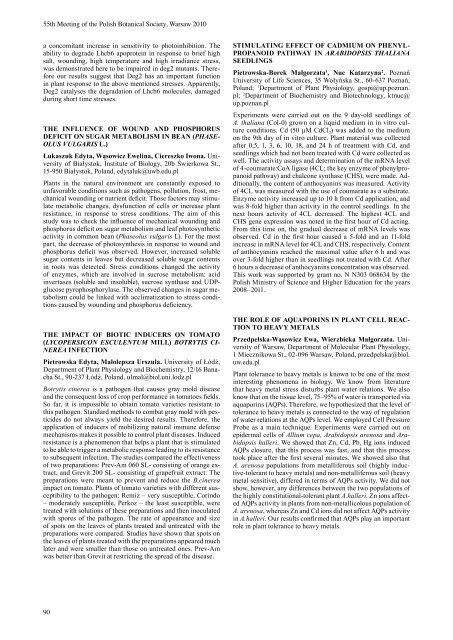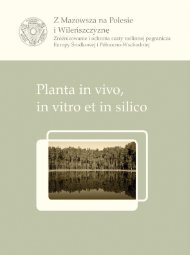acta societatis botanicorum poloniae - LV Zjazd Polskiego ...
acta societatis botanicorum poloniae - LV Zjazd Polskiego ...
acta societatis botanicorum poloniae - LV Zjazd Polskiego ...
Create successful ePaper yourself
Turn your PDF publications into a flip-book with our unique Google optimized e-Paper software.
55th Meeting of the Polish Botanical Society, Warsaw 2010<br />
a concomitant increase in sensitivity to photoinhibition. The<br />
ability to degrade Lhcb6 apoprotein in response to brief high<br />
salt, wounding, high temperature and high irradiance stress,<br />
was demonstrated here to be impaired in deg2 mutants. Therefore<br />
our results suggest that Deg2 has an important function<br />
in plant response to the above mentioned stresses. Apparently,<br />
Deg2 catalyses the degradation of Lhcb6 molecules, damaged<br />
during short time stresses.<br />
THE INFLUENCE OF WOUNd ANd PHOSPHOrUS<br />
dEFICIT ON SUGAr METABOLISM IN BEAN (PhAseolus<br />
vulGAris L.)<br />
Łukaszuk Edyta, Wąsowicz Ewelina, Ciereszko Iwona. University<br />
of Białystok, Institute of Biology, 20b Świerkowa St.,<br />
15-950 Białystok, Poland, edytaluk@uwb.edu.pl<br />
Plants in the natural environment are constantly exposed to<br />
unfavorable conditions such as pathogens, pollution, frost, mechanical<br />
wounding or nutrient deficit. Those factors may stimulate<br />
metabolic changes, dysfunction of cells or increase plant<br />
resistance, in response to stress conditions. The aim of this<br />
study was to check the influence of mechanical wounding and<br />
phosphorus deficit on sugar metabolism and leaf photosynthetic<br />
activity in common bean (Phaseolus vulgaris L). For the most<br />
part, the decrease of photosynthesis in response to wound and<br />
phosphorus deficit was observed. However, increased soluble<br />
sugar contents in leaves but decreased soluble sugar contents<br />
in roots was detected. Stress conditions changed the activity<br />
of enzymes, which are involved in sucrose metabolism: acid<br />
invertases (soluble and insoluble), sucrose synthase and UDPglucose<br />
pyrophosphorylase. The observed changes in sugar metabolism<br />
could be linked with acclimatization to stress conditions<br />
caused by wounding and phosphorus deficiency.<br />
THE IMPACT OF BIOTIC INdUCErS ON TOMATO<br />
(lycoPersicon esculentum MILL) botrytis cinereA<br />
INFECTION<br />
Pietrowska Edyta, Małolepsza Urszula. University of Łódź,<br />
Department of Plant Physiology and Biochemistry, 12/16 Banacha<br />
St., 90-237 Łódź, Poland, ulmal@biol.uni.lodz.pl<br />
Botrytis cinerea is a pathogen that causes gray mold disease<br />
and the consequent loss of crop performance in tomatoes fields.<br />
So far, it is impossible to obtain tomato varieties resistant to<br />
this pathogen. Standard methods to combat gray mold with pesticides<br />
do not always yield the desired results. Therefore, the<br />
application of inducers of mobilizing natural immune defense<br />
mechanisms makes it possible to control plant diseases. Induced<br />
resistance is a phenomenon that helps a plant that is stimulated<br />
to be able to trigger a metabolic response leading to its resistance<br />
to subsequent infection. The studies compared the effectiveness<br />
of two preparations: Prev-Am 060 SL- consisting of orange extract,<br />
and Grevit 200 SL- consisting of grapefruit extract. The<br />
preparations were meant to prevent and reduce the B.cinerea<br />
impact on tomato. Plants of tomato varieties with different susceptibility<br />
to the pathogen: Remiz – very susceptible, Corindo<br />
– moderately susceptible, Perkoz – the least susceptible, were<br />
treated with solutions of these preparations and then inoculated<br />
with spores of the pathogen. The rate of appearance and size<br />
of spots on the leaves of plants treated and untreated with the<br />
preparations were compared. Studies have shown that spots on<br />
the leaves of plants treated with the preparations appeared much<br />
later and were smaller than those on untreated ones. Prev-Am<br />
was better than Grevit at restricting the spread of the disease.<br />
90<br />
STIMULATING EFFECT OF CAdMIUM ON PHENYL-<br />
PrOPANOId PATHWAY IN ArAbidoPsis thAliAnA<br />
SEEdLINGS<br />
Pietrowska-Borek Małgorzata1 , Nuc Katarzyna 2 . Poznań<br />
University of Life Sciences, 35 Wołyńska St., 60-637 Poznań,<br />
Poland; 1Department of Plant Physiology, gospi@up.poznan.<br />
pl; 2Department of Biochemistry and Biotechnology, ktnuc@<br />
up.poznan.pl<br />
Experiments were carried out on the 9 day-old seedlings of<br />
A. thaliana (Col-0) grown on a liquid medium in in vitro culture<br />
conditions. Cd (50 μM CdCl2) was added to the medium<br />
on the 9th day of in vitro culture. Plant material was collected<br />
after 0,5, 1, 3, 6, 10, 18, and 24 h of treatment with Cd, and<br />
seedlings which had not been treated with Cd were collected as<br />
well. The activity assays and determination of the mRNA level<br />
of 4-coumarate:CoA ligase (4CL; the key enzyme of phenylpropanoid<br />
pathway) and chalcone synthase (CHS), were made. Additionally,<br />
the content of anthocyanins was measured. Activity<br />
of 4CL was measured with the use of coumarate as a substrate.<br />
Enzyme activity increased up to 10 h from Cd application, and<br />
was 8-fold higher than activity in the control seedlings. In the<br />
next hours activity of 4CL decreased. The highest 4CL and<br />
CHS gene expression was noted in the first hour of Cd acting.<br />
From this time on, the gradual decrease of mRNA levels was<br />
observed. Cd in the first hour caused a 5-fold and an 11-fold<br />
increase in mRNA level for 4CL and CHS, respectively. Content<br />
of anthocyanins reached the maximal value after 6 h and was<br />
over 3-fold higher than in seedlings not treated with Cd. After<br />
6 hours a decrease of anthocyanins concentration was observed.<br />
This work was supported by grant no. N N303 068634 by the<br />
Polish Ministry of Science and Higher Education for the years<br />
2008– 2011.<br />
THE rOLE OF AqUAPOrINS IN PLANT CELL rEAC-<br />
TION TO HEAVY METALS<br />
Przedpełska-Wąsowicz Ewa, Wierzbicka Małgorzata. University<br />
of Warsaw, Department of Molecular Plant Physiology,<br />
1 Miecznikowa St., 02-096 Warsaw, Poland, przedpelska@biol.<br />
uw.edu.pl<br />
Plant tolerance to heavy metals is known to be one of the most<br />
interesting phenomena in biology. We know from literature<br />
that heavy metal stress disturbs plant water relations. We also<br />
know that on the tissue level, 75– 95% of water is transported via<br />
aquaporins (AQPs). Therefore, we hypothesized that the level of<br />
tolerance to heavy metals is connected to the way of regulation<br />
of water relations at the AQPs level. We employed Cell Pressure<br />
Probe as a main technique. Experiments were carried out on<br />
epidermal cells of Allium cepa, Arabidopsis arenosa and Arabidopsis<br />
halleri. We showed that Zn, Cd, Pb, Hg ions induced<br />
AQPs closure, that this process was fast, and that this process<br />
took place after the first several minutes. We showed also that<br />
A. arenosa populations from metalliferous soil (highly inductive-tolerant<br />
to heavy metals) and non-metalliferous soil (heavy<br />
metal sensitive), differed in terms of AQPs activity. We did not<br />
show, however, any differences between the two populations of<br />
the highly constitutional-tolerant plant A.halleri. Zn ions affected<br />
AQPs activity in plants from non-metallicolous population of<br />
A. arenosa, whereas Zn and Cd ions did not affect AQPs activity<br />
in A.halleri. Our results confirmed that AQPs play an important<br />
role in plant tolerance to heavy metals.



